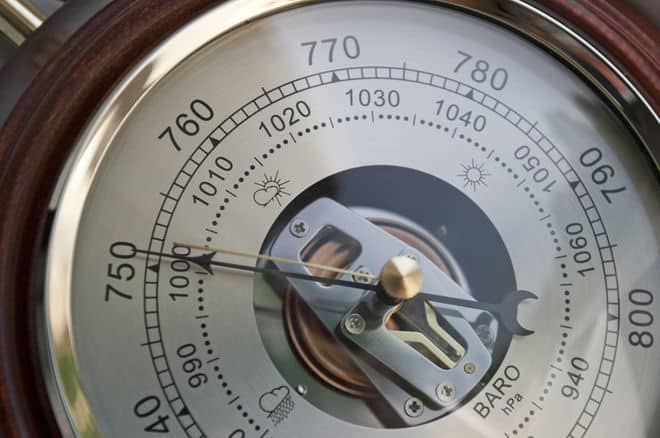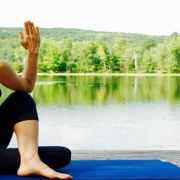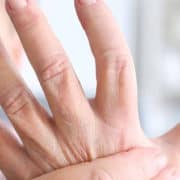Barometric Pressure and Pain
Why Do We Feel Pain When the Weather Changes?
What is Barometric Pressure?
Time for a quick science lesson! Barometric pressure is the amount of atmospheric pressure around the Earth. It’s a measure of the weight of the air that presses down on the earth and the barometric air pressure changes with weather or at different altitudes.
The easiest way to understand this is to imagine a cylinder with a piston inside. The air inside the cylinder is constantly changing because the piston causes it to increase and decrease in volume.
Barometric pressure affects the body by altering the pressure on our joints and muscles. This can lead to pain or arthritis in some people, while others may feel nothing at all.
Beyond chronic pain and arthritis, Barometric pressure can affect people with asthma, chronic obstructive pulmonary disease (COPD), congestive heart failure, cardiovascular disease, temporomandibular joint syndrome (TMJ), panic disorders, and epilepsy.
Why Does Barometric Pressure Affect Some People More Than Others?
We experience the effects of barometric pressure changes every day, but we might not know it. You might be feeling discomfort or even pain after your morning shower, which, among other things, can be due to the atmospheric pressure change that occurred when you took a hot shower and then stepped outside into the cold weather (cold air is more dense than warm air).
It’s not only sudden atmospheric pressure changes that can cause pain; it’s also gradual changes that happen over time. For example, someone who has arthritis will feel increased joint pain as the day progresses because the atmospheric pressure increases.
Do Changes in Weather Really Cause Pain?
Barometric pressure does not directly affect people, but it can influence their health indirectly, for example by changing how they feel pain. There are many studies about how high or low barometric pressure influences people’s health and pain sensitivity.
Researchers have found that high barometric pressure can make people more sensitive to pain while low barometric pressures make them less sensitive to it. So, changes in barometric pressure doesn’t necessarily cause pain, but it does influence how our minds (and thus our bodies) react to it.
Barometric pressure can also affect some people’s moods, by impacting our sensitivity to pain. There have been many studies done to try to figure out this phenomenon and help those who are affected by changes in atmospheric pressure.
Some findings:
– Frequent exposure to barometric pressure changes can increase or decrease the risk of developing arthritis in some people.
– Inflammation markers in some people are impacted by changes in barometric pressure. Inflammation is a main cause of arthritis and other musculoskeletal and joint pain.
– Patients with rheumatoid arthritis or osteoarthritis may be at an increased risk of developing symptoms when there is a change in barometric pressure and cold weather is also present.
Barometric Pressure Changes Make Me Miserable, What Can I Do?
Changing barometric pressure and a drop in temperature can cause joints to ache and swell up due to the expansion and contraction of tendons, muscles, bones and scar tissues. When it’s cold outside, this will happen even more because body fluids will increase in thickness.
If changes in pressure, rapid weather pattern changes and sudden jumps from cold to warm temperatures are causing you trouble, there are a few things you can try:
- Avoid moving quickly between hot and cold environments – Especially if you’re more temperature sensitive, try to keep your climate as even as possible. This means keeping your bedroom heated when you step out of a steamy shower or wearing warm layers when you go outside in the fall or winter, even if it’s just to get the newspaper. These little exposures to temperature swings can increase inflammation, leaving your joints aching long after the temperature change.
- Stay active – Some researchers believe that a decrease in exercise when the weather is unpleasant can lead to an increase in pain and stiffness, rather than the weather conditions. It’s a classic case of the chicken and the egg – which came first? People that aren’t moving as much as they would during the warmer months are much more likely to feel more aches and pains and feel less flexible than they would if they kept up to the usual exercise routine. A good reason to stick to your normal routine, even with bad weather. Mud and pouring rain isn’t much fun, so think about moving your workout indoors with a swim at your local pool or maybe a new fitness class.
- Use a dehumidifier – Some professionals believe that humidity can be to blame for “rainy day pain”. Dehumidifiers are useful when it’s raining or snowing outside. To help you feel better, the humidity in the air should be at 40%-60% for optimum comfort & health.
- Wear compression gear – Wear compression socks, cuffs, and gloves if you have rheumatoid arthritis or other types of chronic pain. Swelling will worsen inflammation which can make your pain worse. You may want to wear them when the barometer drops too.
- Keep your home’s temperature comfortable – to see if there are correlations between the two, try turning up the thermostat – it may help with pain. The correlation between temperature and pain is unclear quite often, but it may help to keep your home at a comfortable temperature.
- Try dipping your hands and feet into a paraffin bath – The wax’s heat is readily absorbed by the body, which may help with soothing aches and pains. You can use a heating pad as well for those hard-to-reach spots.
- See a Chiropractor – Dr. Stephanie Louie has a wide variety of techniques, exercises and stretches that can work together to help you feel better and combat the discomfort you may experience with changes in temperature and weather patterns. Whether you’re experiencing muscle and joint pain due to arthritis, an acute injury, old sports injuries or an old motor vehicle injury, Dr. Louie will be glad to help you.
How Can a Chiropractor Help Relieve Joint Pain?
Barometric pressure changes with altitude and we now know that it does affect our health, even if we don’t know for certain whether rain and cold affects our bodies directly or indirectly. What we do know is that many of us experience pain and inflammation in our bodies, especially when there’s a pre-existing condition like arthritis.
Chiropractic is a technique that has been around for over a century. It deals with the spine and its alignment. The spine plays an important role in the body as it supports the head, ribs, and internal organs.
A chiropractor’s role is to help and make sure everything is functioning in your body as it should. Spinal adjustments and other techniques can help relieve pressure on the nerves and this can help reduce inflammation and swelling on the joints.
Is barometric pressure and the shift from fall to winter leaving you feeling stiff and achy? Are you suffering with sciatica or back pain? Dr. Louie can provide chiropractic therapy, spinal decompression and provide excellent tips for reducing inflammation by living well with exercise and nutrition tailored to your lifestyle and goals. Contact your Victoria chiropractor, Mind Body Spine clinic, to book your initial consultation to start on the path to feeling better, no matter the weather.















